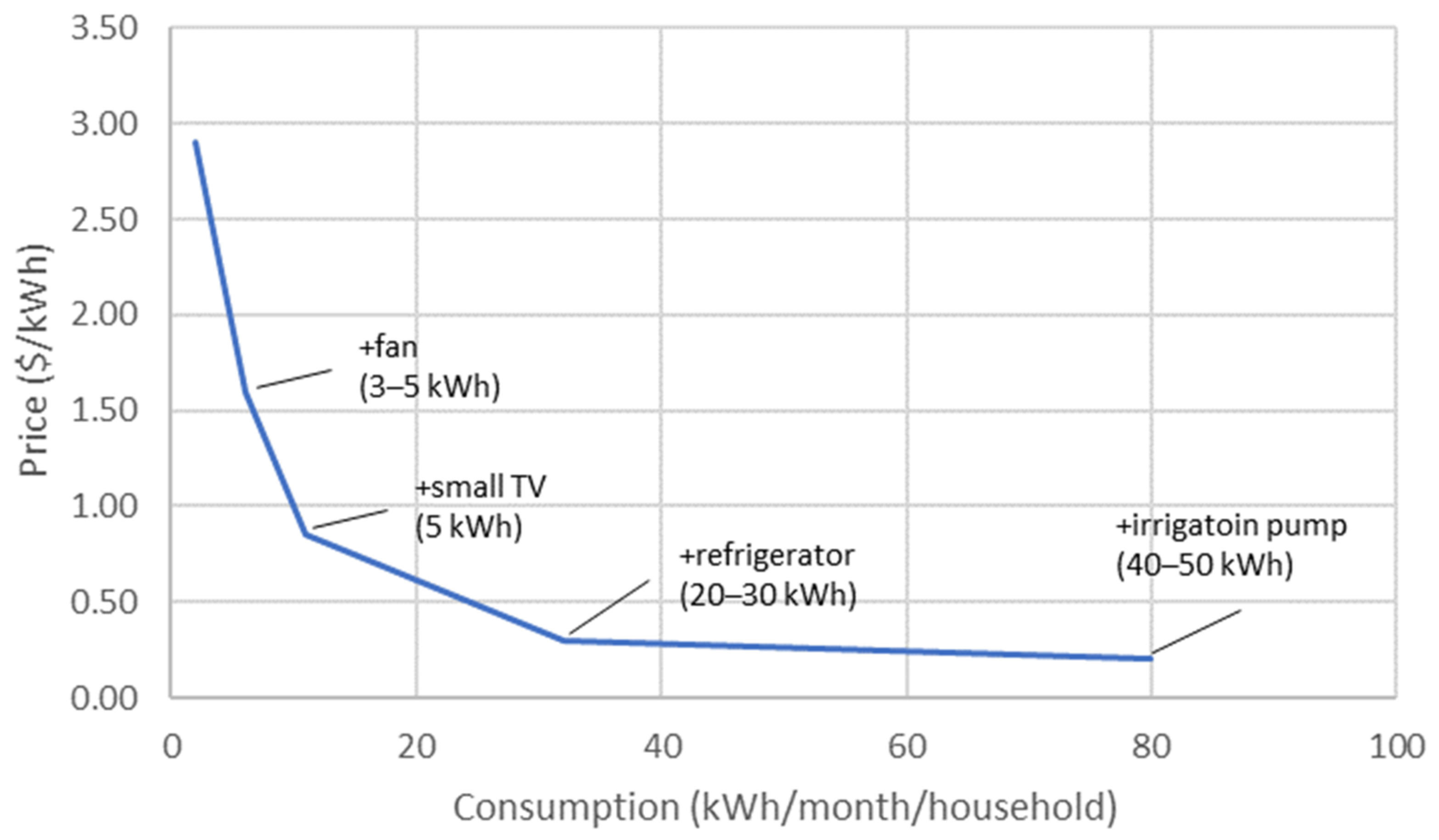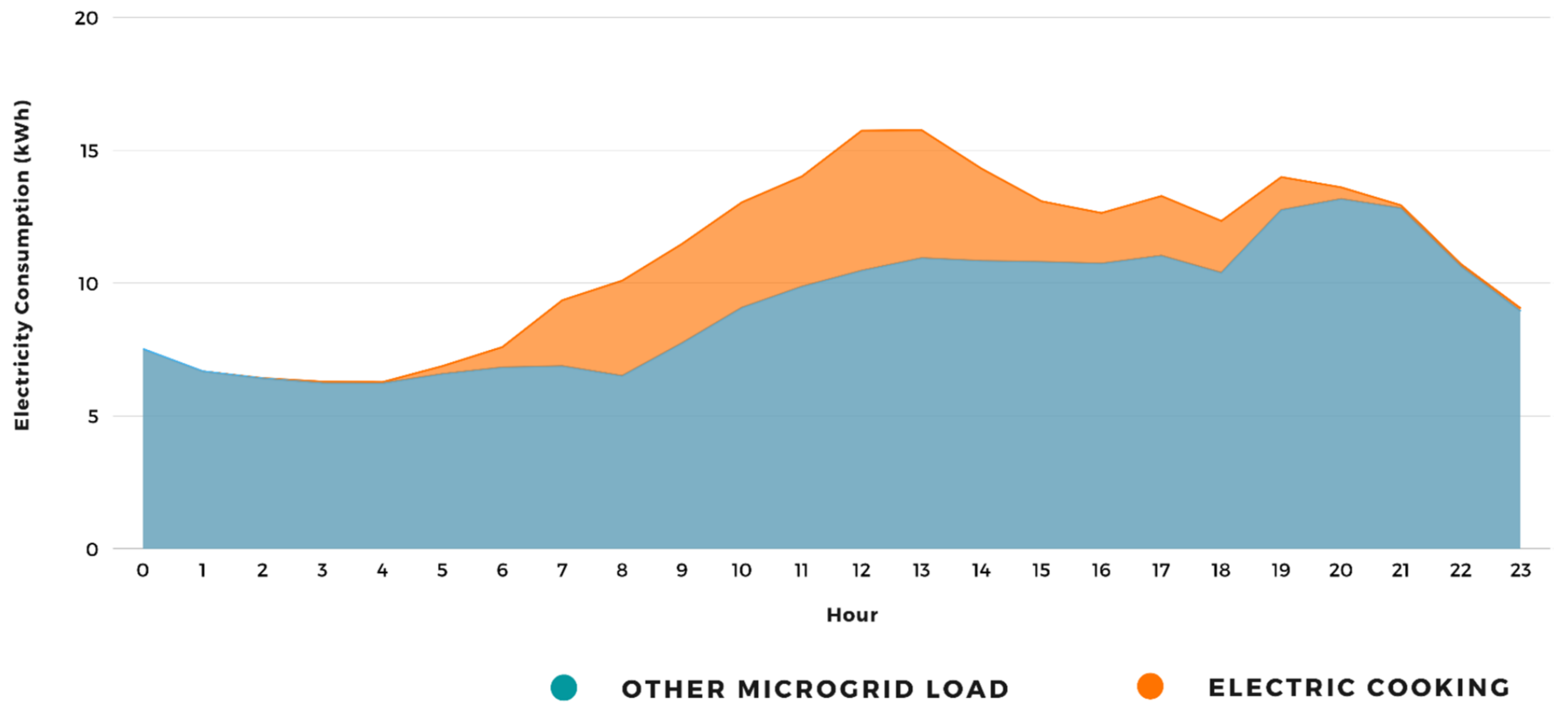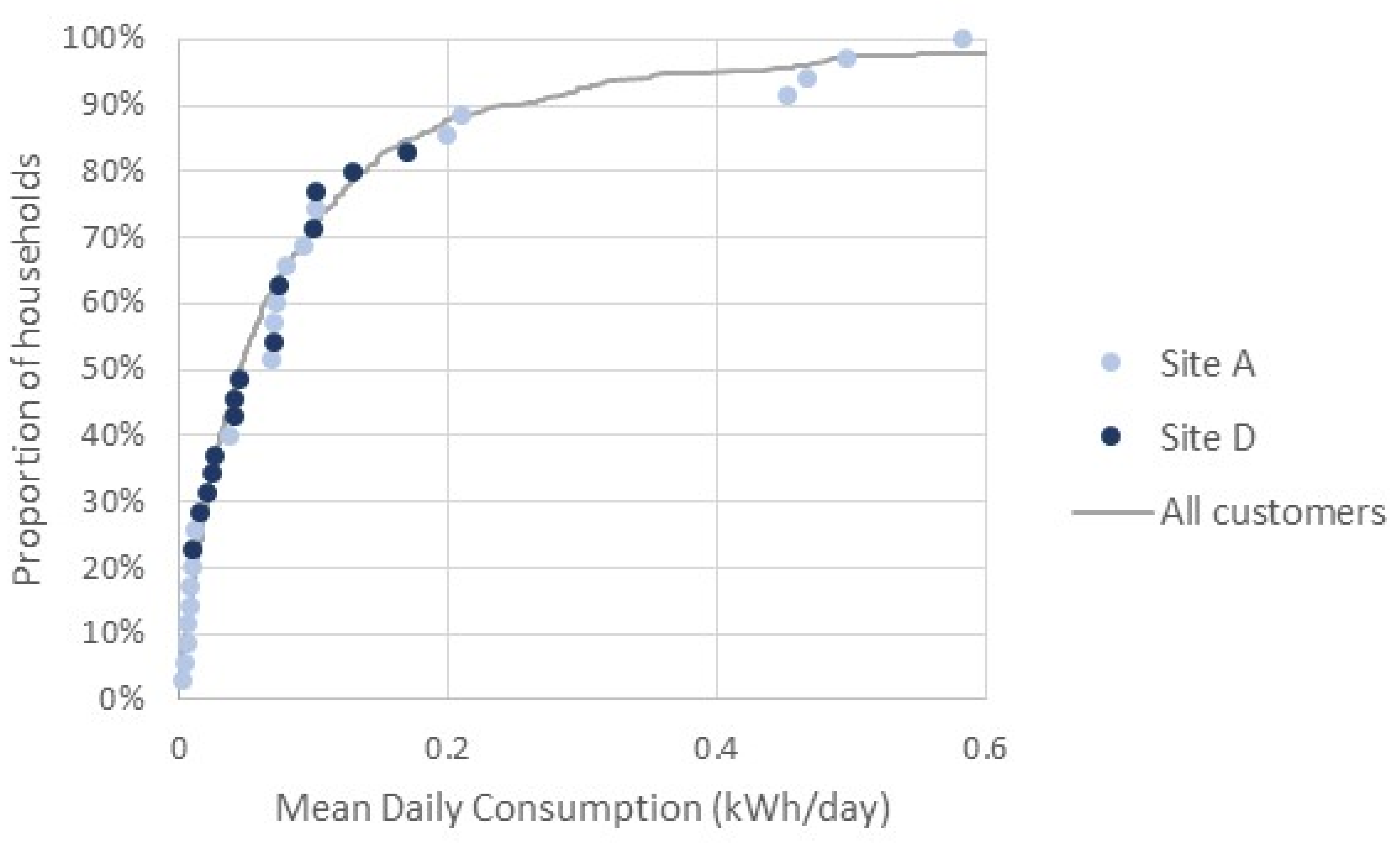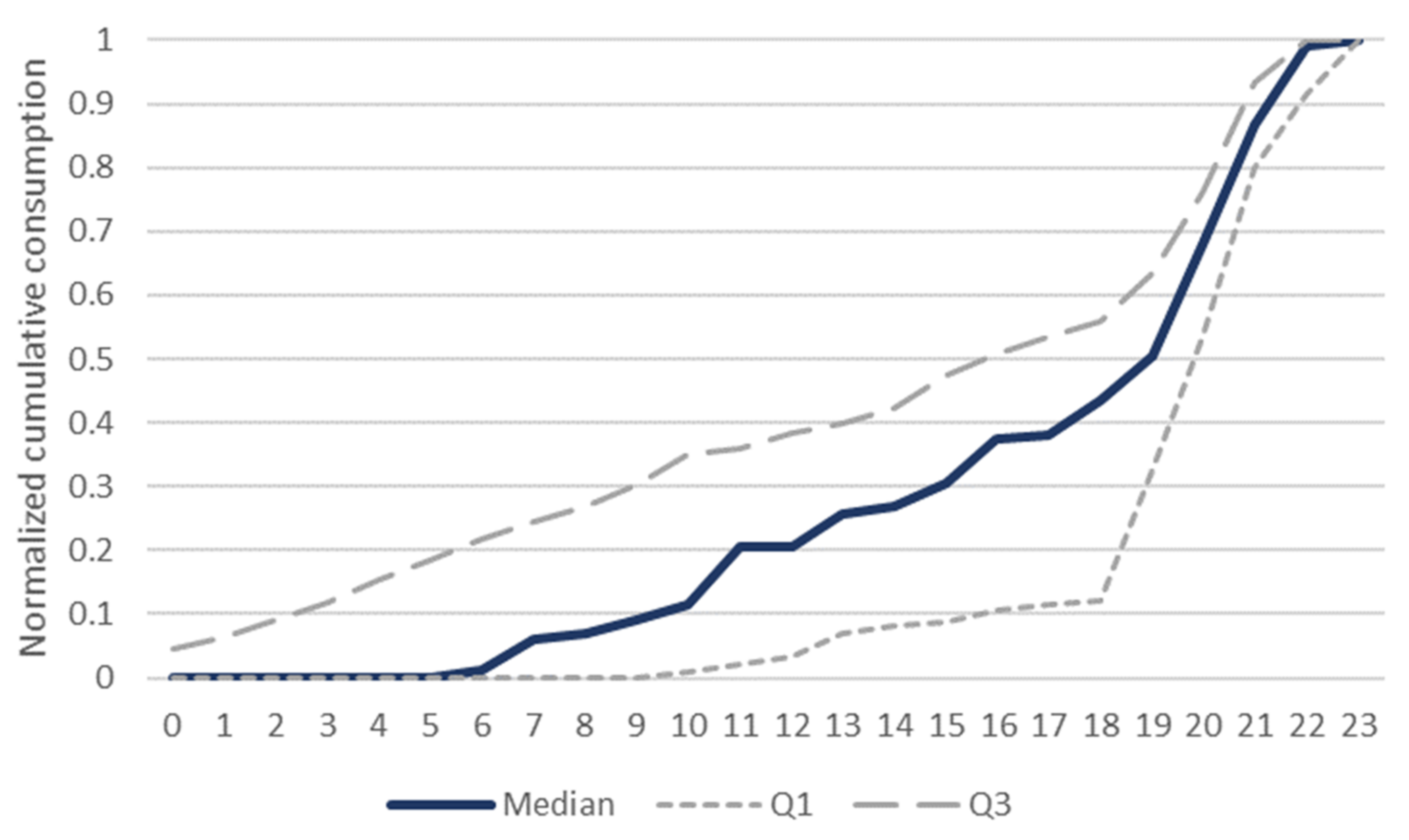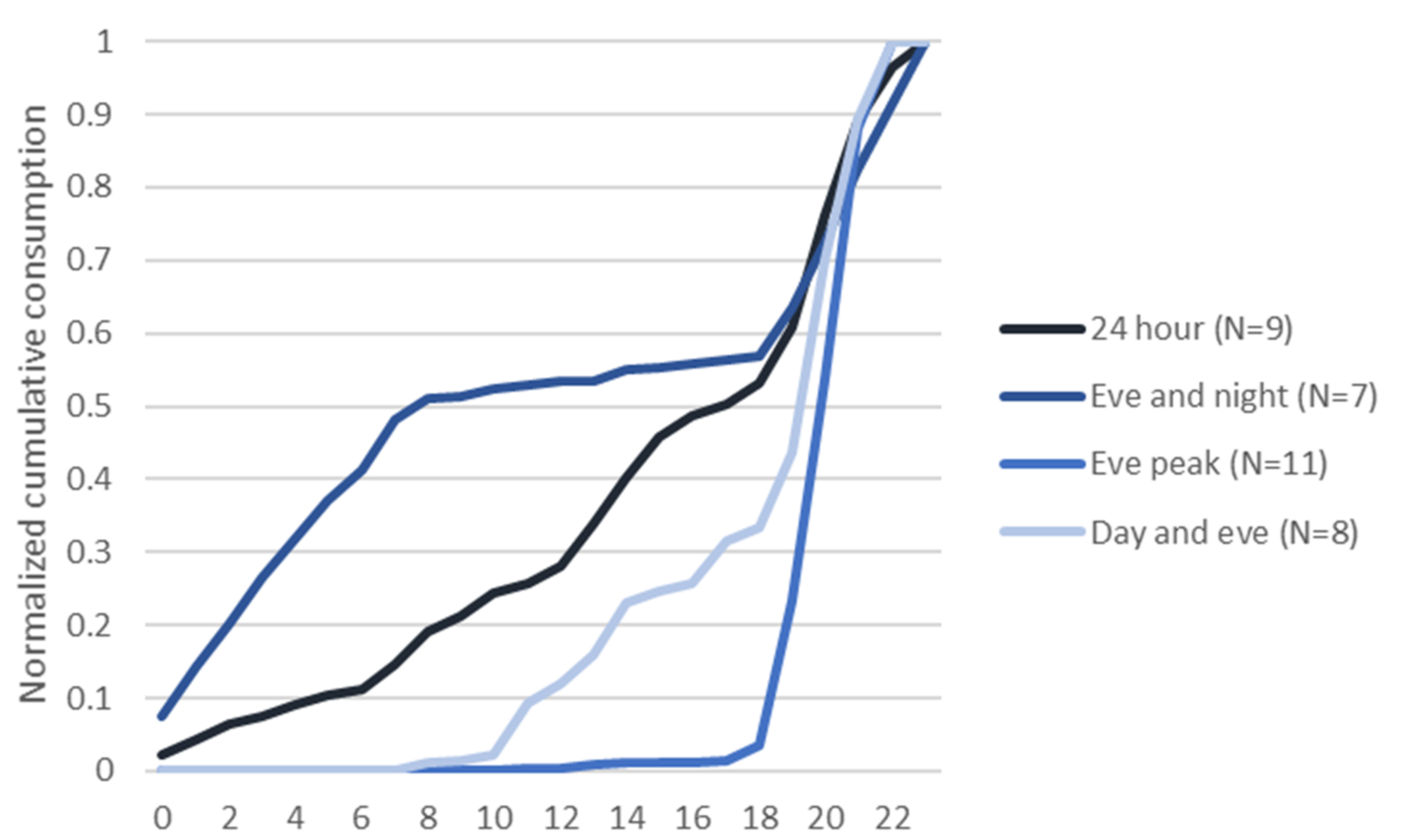1. Introduction
The headline target for Sustainable Development Goal 7 is target 7.1: to “ensure universal access to affordable, reliable and modern energy services” by 2030. The latest SDG Tracking report shows that although progress is being made on improving access to electricity, the rate is not fast enough to achieve the 2030 targets [
1]. Headline figures are a reduction in the number of people globally without access from 1.2 billion in 2010 to 789 million in 2018; however, overall figures hide regional differences. The increase in access has been slowest in sub-Saharan Africa, where only 47% of people have access to electricity (2018) and more recently, the COVID-19 pandemic is reversing progress [
2]. A recent expansion of grid access means that lack of access is now a mostly rural phenomenon—85% of the global access deficit is accounted for by rural areas. Therefore, the report calls for support for off-grid technologies (solar lighting, solar home systems, and mini-grids), which have already played a substantial role in progress to date. The number of people served by off-grid renewable energy sources grew from 10 million to 133 million between 2007 and 2016 [
3]. Estimates indicate that the least costly solutions for reaching remaining households in Africa are national grids (45%), mini-grids (30%), and standalone systems (25%) [
4]. This paper addresses mini-grids, and the opportunities for improving the financial viability of mini-grid projects by integrating electric cooking into consumer demand. For the purposes of this paper, mini-grids are defined as supplying electricity to households within a defined community that is not connected to the national grid. Power may be generated by a diesel genset, but is increasingly generated from renewable sources, and augmented by battery storage [
4].
Households in underserved, rural areas tend to be poor, so the amount of disposable income they have available to spend on electricity is low. Average revenue per user (ARPU) tends to be low, yet this is a key metric for attracting project finance [
5]. ARPU is a product of the amount of electricity used and the tariff charged so both aspects are of interest. Of course, they are intrinsically linked, such that consumption will increase as tariffs drop and vice versa, as illustrated in
Figure 1. For example, the Access to Energy Institute (A2EI) have shown that use of electric pressure cookers (EPCs) on a mini-grid in Tanzania increased sharply when the tariff was reduced [
6].
Solar photovoltaic (PV) has become the dominant energy generation technology deployed on mini-grids [
5]. Solar resource is high and uniformly available across most developing country locations, making it widely applicable. The cost of PV panels has also dropped dramatically over recent years and is expected to continue to fall [
5]. Advances in related technology such as batteries, control, and data analytics also contribute to falling mini-grid costs. Battery storage costs, in particular, play an important role in the financial viability of mini-grids, especially those based on intermittent renewable sources (e.g., solar, wind), and large-scale manufacturing is forecast to result in steep falls in energy storage costs up to 2030 [
8]. However, items associated with generation (e.g., PV panels, batteries, inverters) typically account for only about half of total capex; the remainder is distribution network, metering, licenses, labor, taxes etc. [
5].
The dynamic nature of loads affects the mini-grid system cost and the cost-recovery tariff. Along with system capacity (peak power) and the amount of electricity sold, key techno-economic considerations include capacity factor (energy sold as a proportion of total energy generation potential) and load factor (peak power demand as a proportion of average demand) [
9]. Furthermore, the dynamic nature of loads throughout the day are especially important for mini-grids powered by intermittent energy sources, such as solar PV. Where energy demand takes place during daylight hours, when the solar resource is available, the need for energy storage is reduced, which reduces system capex costs [
10]. For this reason, developers are keen to identify productive loads as anchor customers, given that businesses tend to operate during the daytime, giving a good match with energy production [
11]. The most common types of load include services (e.g., barbers), small industry (e.g., welding, carpentry), agri-processing (e.g., milling), telecoms, and refrigeration [
5].
Figure 1 illustrates how adding an agricultural load to a household can have a dramatic effect on the break-even tariff.
However, this literature misses the opportunity presented by electric cooking to increase demand. Moreover, in some countries, the main demand for cooking energy occurs in the middle of the day, making it an ideal load for solar PV mini-grids;
Figure 2 presents an example from Haiti. However, recent studies have started to explore the cost implications of adding cooking loads to mini-grids. For example, Keddar et al. (2020) show that optimally sizing a PV battery system with diesel generator backup to meet cooking loads on a mini-grid can reduce the cost of energy by 70% (from 1.47 USD/kWh to 0.43 USD/kWh) [
12].
Understanding consumer loads is a crucial part of mini-grid system design [
14,
15]. Overestimating loads means that a system will be oversized, so capital expenditure will be unnecessarily high and revenues less than expected. Conversely, underestimating loads means that a system will not have the capacity to meet demand, leading to poor customer satisfaction. Accurate estimation of consumer loads is therefore important, but many mini-grid installations target consumer groups which have had limited or no previous access to electricity, making estimation challenging [
16]. Mandelli et al. [
17] briefly overview commonly used techniques that generate load profiles for a given mini-grid (the characterization of variation in electricity consumption over time) by using a combination of load profiles from similar contexts and household surveys [
18,
19]. Recently, academics including Mandelli et al. have also developed software which attempt to generate these profiles using mathematical models [
20,
21,
22].
These approaches rely on load profiles from consumer groups in similar contexts to the mini-grid in question, but data from low income households in Africa are lacking. Lorenzoni et al. (2020) identify a few initiatives gathering data on load profiles before conducting an analysis of 66 load profiles from around the world [
23]. One exception is the South African Electrical Load Study data [
24], although this may have limited applicability to the rest of sub-Saharan Africa.
In the absence of load profile data, developers tend to resort to surveys as the best way of estimating potential demand. Load profiles can then be generated from estimates of appliances and power ratings, coupled with time of day patterns of use. One study that conducted both surveys and subsequent electrical monitoring showed distinct differences between load profiles based on interviews and measured data (mainly during the night and in morning usage) [
18], underlining the importance of publicly available data on load profiles. This paper makes a contribution to filling this gap by presenting load profile data from mini-grids in Tanzania. It complements data from similar sites in Tanzania [
25] in a study that explored the use of demographic variables as predictors of customer type.
The same team has published further work demonstrating how mini-grid customers in Tanzania can be divided into five distinct load profile types [
26]. This kind of customer segmentation, based on clustering techniques, is important to energy utilities more widely and can be used, for example, for energy efficiency campaigns, pricing, energy forecasting, and distributed generation planning [
24].
In the absence of comprehensive data on electrical consumption characteristics of mini-grid customers in low income countries, developers resort to modelling for the purposes of system sizing and financial assessment. The paper presents load profile data from mini-grids in Tanzania. In order to inform modelling approaches, the analysis provides some understanding of the factors that lie behind electrical load profiles exhibited by different groups of mini-grid customers.
2. Methods and Data
2.1. Methods
The paper is based on electricity consumption data combined with customer data (demographic and asset ownership). Metered electricity consumption data for mini-grid customers were provided by PowerGen Renewable Energy. Customer data were generated from household surveys conducted through face to face interviews implemented by the Modern Energy Cooking Services (MECS) program. Both sets of data were generated as part of a broader study initiated by A2EI.
The pilot study in six mini-grid sites in northern Tanzania set out to explore whether EPCs are socially acceptable and useful, and technically and financially viable, as a clean cooking solution for mini-grid customers. The study was conducted in collaboration with Nexleaf Analytics, PowerGen, and the MECS program. Under the study, a total of 100 households from across all six sites were equipped with EPCs. A subset of households drawn from only two sites were recruited into a detailed study, which included the customer data survey.
The analysis starts in
Section 3 by considering demand across all customers in the two sites of interest, looking at variations across the day (24 h profiles), across the week (by day of the week), and seasonally (by month). It then moves on to considering the daily consumption and links to both demographics and electrical asset ownership using variables collected for the detailed study sample only (35 households). In
Section 5, the 35 households are categorized according to the shape of their 24 h load profile using a k-means clustering algorithm. Both demographic and electrical asset variables are disaggregated by load profile category to explore factors lying behind the different profile shapes. The analysis was carried out using SPSS.
2.2. Description of Datasets
The two sites were chosen to reflect the diversity of communities served by PowerGen mini-grids. Site A is an island community, poor and isolated with buildings arranged at high density. Site D is a small rural village on the mainland, more spread out in terms of placement of houses and shops. It is the central village to six smaller sub-villages, two of which are also connected to the mini-grid.
Tariffs on these mini-grids were high relative to the national grid. Customers on the island site (Site A) were charged a flat tariff (independent of consumption) and mainland customers (Site D) were charged a block rate tariff, attracting a 37.5% discount if they used at least 3 kWh in a month. These sites have mixed generation (solar PV with battery storage and diesel backup) designed to have adequate capacity to meet demand so customers were not restricted as to the electrical devices they could use.
Electrical load data (hourly frequency) provided covered the period from their introduction to the community up to the end of 2019.
Site A: 1,735,779 records; April–December 2019;
Site D: 2,029,135 records; March 2018–December 2019.
For each site, these records comprised the following data:
For the purposes of this analysis, the hourly meter data were aggregated into a wide format, in which each record represented a single day, with 24 variables containing the energy consumption data for each hour of the day. Note that some readings were missing from the meter dataset, so the analysis has been conducted only on those records containing a full set of 24 hourly values. The analysis is based on 12 months of metering data for Site D covering all of 2019, and eight months of data for Site A covering May to December 2019.
Researchers from the University of Strathclyde (part of the MECS team) had developed a survey tool under a different cooking related program [
27]. For the purposes of the detailed study of a sub-set of households, the survey was adapted to gather data on electrical household assets. It also included a series of poverty assessment questions following the PPI methodology, both of which are of value to this study. The survey was conducted in June 2020. The household survey data were gathered from 42 households from both Site A and Site D via face-to-face interviews with adult respondents, usually the female spouse of the household head. Thirty-five surveys could subsequently be paired with PowerGen meter numbers for which there were valid electrical metering data (21 households from Site A and 14 from Site D).
Load profile data are presented for all households in each of the two sites in
Section 3. The rest of the analysis has been conducted on the 35 households from the detailed study sample for which electricity metering data were available. The demographic and asset data for each customer were merged into each complete 24 h load profile data record. The number of households and the number of complete 24 h load profiles used in the analysis are presented in
Table 1.
2.3. Household Demographics
All respondents to the household survey were women apart from two men, both from Site D.
Site A had a much wider range of age of respondents, and the mean age of respondents was higher (39 years old compared with 32 years for Site D). The majority of respondents from Site D were aged 30–34 years.
Respondents from Site A had attained a higher level of education than those from Site D (
Table 2).
With an average household size of 5.3, households from Site A were marginally smaller than those from Site D (average of 5.7).
The survey included a range of variables used to construct a PPI score in accordance with the Poverty Probability Index methodology [
28]. The PPI methodology uses 10 questions on household characteristics and asset ownership to assess the probability of a household living below the national poverty line. Higher scores reflect a higher probability of being below the poverty line, so higher scores represent poorer households. Scores indicate that households from Site A have a higher probability of being below the national poverty line (6.2%) than those from Site D (3.7%).
6. Conclusions
Load profiles from the two communities demonstrate four distinct patterns of use based on the shape of the load profiles. All households exhibited a peak in demand during the evening; two groups exhibited demand throughout the night, and two exhibited demand throughout the day. One possible explanation is that these patterns of use reflect different occupancy schedules. In addition to demographic data, this paper has also analyzed data on household electrical asset ownership in exploring linkages with these patterns of use.
The results show that patterns of use depend on a complex mix of factors:
Load profiles can be linked to poverty, but not necessarily as might be expected. For example, some low-status households use electricity throughout the night, which contributes to relatively high consumption figures. This may reflect security concerns, but this would need further investigation. Conversely, other households that have a reasonable mix of appliances but use them sparingly, resulting in low levels of electricity consumption, have a relatively low probability of being poor.
Asset ownership and electricity consumption are not necessarily linked to socio-economic status. For example, the group with the lowest level of electricity consumption are relatively asset-poor, but are far from the poorest households. On the other hand, high-cost items, which also have high power ratings (notably fridges and TVs), are more frequently found in households with high levels of electricity consumption that exhibit demand throughout the 24 h period and also have a higher socio-economic status.
Asset ownership is linked to electricity consumption, albeit weakly. The group with highest electricity consumption has the highest levels of asset ownership, whilst the group with lowest consumption is relatively asset-poor. Ownership of assets with high power ratings, such as fridges and TVs, are linked with higher electricity consumption, but this is not necessarily the case for other appliances.
With appliance ownership and poverty showing relatively weak relationships with energy consumption, it is proposed that patterns of use based on occupancy can be the dominant factor in determining energy consumption rather than the number of appliances, e.g., demand among working households could be lower during working hours. However, occupancy cannot fully explain profiles. For example, some households use electricity at night while others do not, yet it can be assumed that most households will be occupied at night.
Patterns of use are not linked to household composition. There is no clear link with the number of children in the household, and household sizes are similar across all groups.
The distinct shapes of load profiles for each of the groups highlight the importance of understanding patterns of use for modelling. When coupled with energy consumption data, this can be used not only for customer segmentation, but also for system sizing according to demand variation throughout the day.
The paper makes a contribution to understanding the composition of electrical appliances within households with different load profile characteristics, and the interdependence between appliances and load profiles. It demonstrates that different load profiles are determined by a complex mix of appliance ownership, occupancy, and socio-economic status. In order to further test the role of occupancy in load profiles, the MECS program will be gathering household occupancy data as part of ongoing studies.
